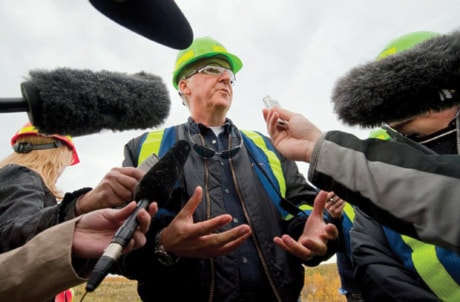Movie director James Cameron can teach Alberta politicians some things about their own craft.
Before visiting this week, he was widely slagged in Alberta as a self-aggrandizing, know-nothing Los Angeles celebrity.
He proved that’s not true.
Cameron obviously did considerable study on the oilsands before arriving here. He listened carefully as he was toured around by politicians, oil executives and aboriginal leaders.
At a news conference on Wednesday after those meetings, he was able to speak fluidly for 30 minutes without notes, responding effectively to reporters’ questions.
Many Albertans wish that some of our politicians, especially our premier, could do as well.
Cameron also had the political smarts to acknowledge that he was wrong when he previously referred to the oilsands as a “black eye” for Alberta.
In a meeting with The Edmonton Journal editorial board, Cameron admitted that he was “ill-informed” in making that statement.
Then, he extended the point to an unassailable conclusion: “It has the capacity to be the biggest black eye in Canadian history or it’s got the capacity to be a place in which Alberta and Canada rise to a challenge and show leadership.”
Amen, Brother Cameron.
Extracting oil more deliberately, with ever-increasing sophistication and environmental awareness, will be good for Alberta, Canada and the world.
Remember, the resource belongs to Albertans, not the government and not the oil companies.
The petroleum in Alberta’s three major oilsands deposits — near Fort McMurray, Cold Lake and Peace River — has been in the ground for millions of years. It can be a financial boon to generations of future Albertans if we manage it right.
It hasn’t always been done that way.
The first deposits, at or near the ground’s surface around Fort McMurray, were strip mined, with environmental consequences that we have only recently begun to appreciate.
The consortium of oil companies that made up Syncrude was so anxious to begin producing oil as fast as possible that they signed cost-plus contracts with the construction companies.
The more those companies spent building the plant, the higher their profits rose. There was no constraint on costs.
That fact, coupled with the massive size of Syncrude, was a key element in driving up massive inflation rates across Canada in the late 1970s. That ultimately killed businesses, jobs and cost many Albertans their homes.
For a long time, Albertans received only a one per cent royalty on every barrel produced until the oil companies had fully recouped all their extravagant construction costs.
The insanity of reckless boom-time spending began to repeat itself in the oilpatch again this decade, until the global financial meltdown brought it up short.
Alberta has a chance to get it right in the third wave of oilsands development that is now upon us.
From an environmental perspective, some things are improving by default, if not by design.
New plants, like those of Suncor, are extracting the bitumen with steam-injected underground pipes, rather than pit mines.
It’s more expensive but produces far fewer toxic emissions. The process uses a lot of water, but 95 per cent of it is recycled and re-used.
Big oil companies think in generation‑long strategic planning cycles rather than the time horizons of politicians, which often seem as short as the next news cycle.
They know that Alberta’s oilsands are a massive long-term financial and strategic resource. They know that oil cannot be easily or cheaply replaced as a fuel source. They know that as oil reserves dwindle globally, its price will rise.
They know, without question, that environmental stewardship has become a huge factor in their ability to generate profits and attract investment. (See: BP, Gulf oil spill)
Alberta politicians must know this, too.
We can develop our resources prudently, patiently and profitably in an environmentally responsible manner.
That’s something Cameron knows well.
His business and his personal habits produce a substantial carbon footprint. He lives in an 8,300-square-foot house in Malibu, adjacent to a 6,700-square-foot house that he uses as a movie production centre.
Cameron frequently flies on private jets but he had the political savvy to arrive in Edmonton this week on a commercial airliner.
But Cameron did not come to fame and fortune as the most powerful person in Hollywood (according to a recent poll of his peers) because he’s an environmental paragon or makes the world’s best movies.
He’s revered because he consistently makes the most profitable movies.
Cameron spends a lot of time, energy and thought before greenlighting any new project.
In dealing with the oilsands, that’s another area where the Alberta government could follow his lead.
Joe McLaughlin retired from the Advocate last year after 25 years as managing editor.
